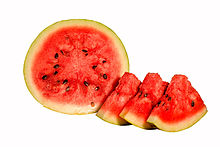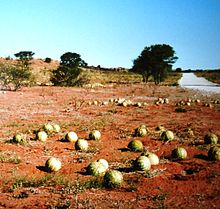**1. Botanical Information and Taxonomy:**
– Watermelon belongs to the species Citrullus lanatus.
– The plant was first described by Carl Linnaeus as Cucurbita citrullus and later reassigned to Citrullus by Heinrich Adolf Schrader.
– Molecular data shows a distinction between sweet watermelon and bitter wooly melon.
– Varieties like bitter wooly melon and citron melons exist within the species.
– The kordofan melon from Sudan may be the progenitor of modern watermelon.
**2. Cultivation and Production:**
– Watermelon is grown in favorable climates globally for its large edible fruit.
– China leads in global watermelon production, accounting for about two-thirds of the world’s total in 2017.
– Major pests include aphids, fruit flies, and root-knot nematodes.
– Watermelon production reached 101.6 million tonnes globally in 2020, with China contributing 60%.
– Watermelons thrive in tropical to temperate climates with temperatures above 25°C (77°F).
**3. Culinary Uses and Nutritional Information:**
– Watermelon can be consumed fresh, pickled, or cooked.
– The fruit is 91% water, low in fat, and contains sugars and carotenoids like lycopene.
– Watermelon is a good source of vitamins A, B, C, and minerals like calcium, iron, and potassium.
– Watermelon seeds can be roasted, ground into flour, or dried for consumption.
– Seedless varieties have been developed using triploid varieties.
**4. Historical Significance and Symbolism:**
– Watermelons have a long history, with seeds found in ancient settlements in the Dead Sea region.
– Cultivation dates back to India in the 7th century and China in the 10th century.
– Watermelon has been symbolically associated with various regions and movements, including Palestinian resistance and Eco-socialism.
– The fruit has also been used in racist stereotypes in the United States.
– Watermelon’s significance in different cultures and historical contexts is notable.
**5. Varieties and Cultivars:**
– There are over 1,000 watermelon varieties cultivated globally, grouped into Citroides, Lanatus, and Vulgaris.
– Notable cultivars include the Carolina Cross, Golden Midget, and Densuke watermelon.
– Breeding efforts have developed disease-resistant varieties like the ‘gray melon from Charleston’ and Jubilee.
– Different watermelon varieties offer unique characteristics like adaptability to cool climates or high prices.
– Watermelon farming is conducted in approximately 44 states in the U.S., with Georgia, Florida, Texas, California, and Arizona as top producers.
Watermelon (Citrullus lanatus) is a flowering plant species of the Cucurbitaceae family and the name of its edible fruit. A scrambling and trailing vine-like plant, it is a highly cultivated fruit worldwide, with more than 1,000 varieties.
| Watermelon | |
|---|---|

| |
| Watermelon | |

| |
| Watermelon cross section | |
| Scientific classification | |
| Kingdom: | Plantae |
| Clade: | Tracheophytes |
| Clade: | Angiosperms |
| Clade: | Eudicots |
| Clade: | Rosids |
| Order: | Cucurbitales |
| Family: | Cucurbitaceae |
| Genus: | Citrullus |
| Species: | C. lanatus
|
| Binomial name | |
| Citrullus lanatus | |
| Synonyms | |
|
List
| |


Watermelon is grown in favorable climates from tropical to temperate regions worldwide for its large edible fruit, which is a berry with a hard rind and no internal divisions, and is botanically called a pepo. The sweet, juicy flesh is usually deep red to pink, with many black seeds, although seedless varieties exist. The fruit can be eaten raw or pickled, and the rind is edible after cooking. It may also be consumed as a juice or an ingredient in mixed beverages.
Kordofan melons from Sudan are the closest relatives and may be progenitors of modern, cultivated watermelons. Wild watermelon seeds were found in Uan Muhuggiag, a prehistoric site in Libya that dates to approximately 3500 BC. In 2022, a study was released that traced 6,000-year-old watermelon seeds found in the Libyan desert to the Egusi seeds of Nigeria, West Africa. Watermelons were domesticated in north-east Africa, and cultivated in Egypt by 2000 BC, although they were not the sweet modern variety. Sweet dessert watermelons spread across the Mediterranean world during Roman times.
Considerable breeding effort has developed disease-resistant varieties. Many cultivars are available that produce mature fruit within 100 days of planting. In 2017, China produced about two-thirds of the world's total of watermelons.
